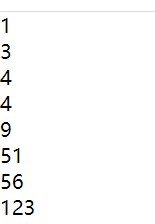Fragments
vue3.0支持了多根节点的组件,也就是片段(Fragments)
<template> <header>header</header> <main>main</main> <footer>footer</footer> </template>
Fragment好处
1>减少了很多无意义的div
2>实现组件递归
我们定义一个组件fragment.vue
<template>
<div>
<honey></honey>
</div>
</template>
<script>
export default {
name:'honey'
}
</script>
<style scoped>
</style>
app.vue
<template>
<div>
<fragment></fragment>
</div>
</template>
<script>
import fragment from "./components/fragment.vue"
export default {
components:{
fragment
}
}
</script>
<style scoped>
</style>
此时浏览器会报错:超出了浏览器最大堆栈,要使用递归组件需要有条件判断

因为再这里我们实现的是一个组件的递归,在当前组件中无限制的调用当前的自身,这就成了死递归,要是用递归组件,必须要有条件判断
app.vue
<template>
<div>
<fragment :data="[4,1,56,123,4,9,51,3,]"></fragment>
</div>
</template>
fragment.vue
<template>
<horintal :data="leftarr" v-if="leftarr.length"></horintal>
<div>{{m}}</div>
<horintal :data="rightarr" v-if="rightarr.length"></horintal>
</template>
<script>
export default {
name:'horintal',
props:{
data:Array
},
setup(props){
// 获取数组中第一个值作为一个中间值
let m=props.data[0]
// 存放比m小的值
const leftarr=[];
// 存放比m大的值
const rightarr=[];
props.data.slice(1).forEach(v=>{
v>m?rightarr.push(v):leftarr.push(v)
})
return {m,leftarr,rightarr}
}
}
</script>
<style scoped>
</style>



